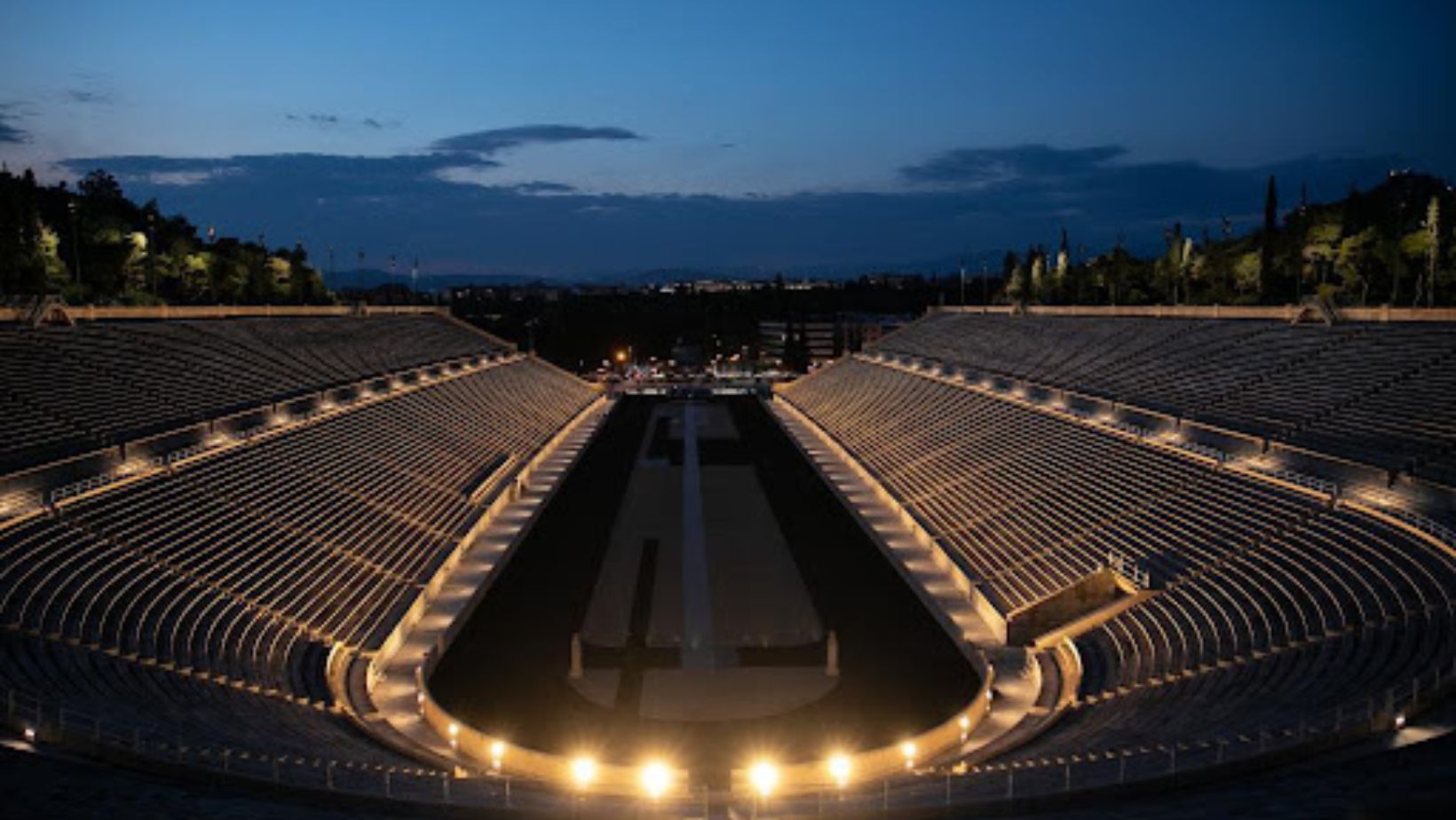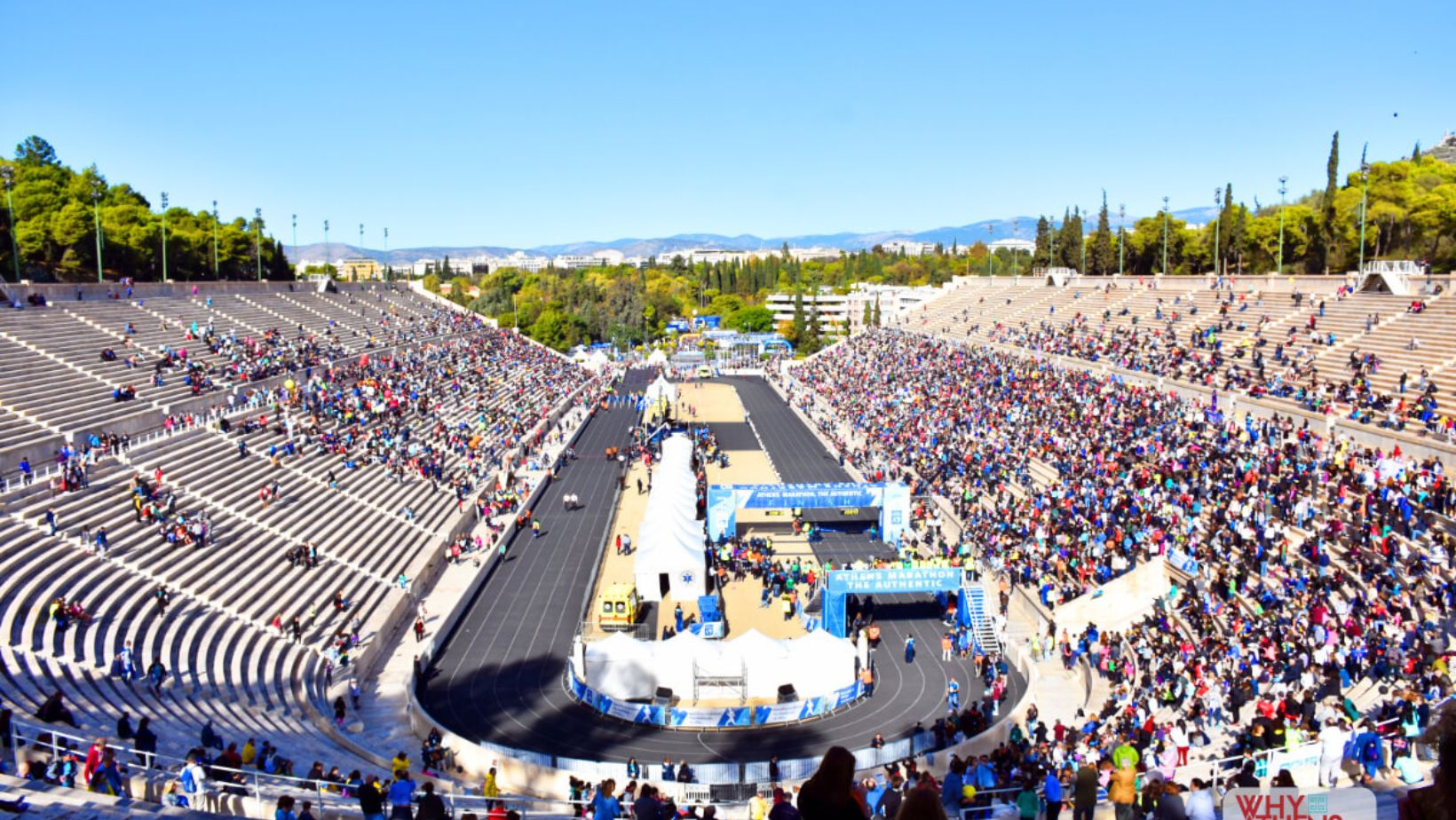Have you ever stood at the edge of a world that’s centuries old, where legends once competed for glory? That’s exactly what stepping into an Ancient Olympic Stadiums feels like. These majestic buildings are more than just echoes from the past; they’re open doors, inviting us on an adventure to see how people long ago embraced sports and rivalry. From the first recorded games in 776 B.C., these stadiums have witnessed feats of strength, speed, and spirit that laid down the foundations for today’s global sporting events.
Table of Contents:
- The History and Significance of the Panathenaic Stadium
- Exploring the Ruins of the Ancient Olympic Stadium in Olympia
- The Role of Stadiums in the Modern Olympic Games
- Visiting the Panathenaic Stadium Today
- Conclusion
The History and Significance of the Panathenaic Stadium: Ancient Olympic Stadiums

The Panathenaic Stadium is a true marvel of ancient Greek architecture and a testament to the Olympic Games’ enduring legacy.
This iconic stadium, nestled in the heart of Athens, has a rich history dating back to the 4th century BC.
Originally built for the Panathenaic Games, an ancient Greek athletic festival held in honor of the goddess Athena, the stadium has undergone several transformations over the centuries.
The first iteration of the stadium was a simple, rectangular track, typical of ancient Greek stadiums like those found in Olympia and Epidaurus.
The Panathenaic Games
The Panathenaic Games were a significant part of ancient Greek culture, drawing athletes and spectators from across the Greek world.
At the Panathenaic Stadium, attendees got their fill of excitement with a lineup that included everything from sprinting and wrestling to boxing and chariot races.
In the 2nd century AD, the wealthy Roman senator Herodes Atticus financed a major reconstruction of the stadium, transforming it into a grand, marble-clad structure.
The renovated stadium featured a horseshoe shape, typical of Roman-era stadiums, and could seat up to 50,000 spectators.
Significance in Ancient Greek Culture: Ancient Olympic Stadiums
The Panathenaic Stadium played a central role in ancient Greek society, serving as a gathering place for athletic competitions, religious festivals, and cultural events.
Its grandeur and beauty were a source of pride for Athenians and a symbol of the city’s power and prestige in the ancient world.
Exploring the Ruins of the Ancient Olympic Stadium in Olympia: Ancient Olympic Stadiums
The ancient stadium of Olympia, located in the western Peloponnese region of Greece, is a fascinating archaeological site that offers a glimpse into the birthplace of the Olympic Games.
The stadium at Olympia was originally situated east of the sanctuary of Zeus, but over time, it was gradually moved and expanded.
By the 5th century BC, the stadium had taken its final form, with a rectangular track measuring approximately 212 meters long and 28 meters wide.
Up to 45,000 fans could fit into the stadium, where many found a cozy spot on the grass-covered hills around the track to watch the action.
Hosting the Ancient Olympic Games: Ancient Olympic Stadiums
For over a millennium, the stadium at Olympia hosted the ancient Olympic Games, a quadrennial festival that drew athletes and spectators from across the Greek world.
The games were held in honor of Zeus, and the stadium was the centerpiece of the festivities, hosting events such as foot races, wrestling, boxing, and chariot racing.
Uncovering the Ruins Through Archaeology
Digging into the past at the old stadium site has been like opening a treasure chest, giving us a fascinating peek into its construction and history.
Archaeologists have uncovered the remains of the track, the starting line, and the stone seating for judges and officials.
Digging into these finds, we’ve really started to piece together how the ancient Olympic Games were run and just how crucial the stadium was to this legendary celebration.
The Role of Stadiums in the Modern Olympic Games: Ancient Olympic Stadiums
Since their revival in 1896, stadiums have been integral to the modern Olympic Games. They serve as the primary venues for the opening and closing ceremonies, as well as for track and field events.
Over the past century, Olympic stadium design has evolved significantly, reflecting advances in architecture, engineering, and technology.
Early modern Olympic stadiums, such as the Panathenaic Stadium in Athens (1896) and the White City Stadium in London (1908), were relatively simple structures often made of wood or stone.
In contrast, contemporary Olympic stadiums are modern design marvels, featuring state-of-the-art facilities, retractable roofs, and sustainable building materials.
Iconic Modern Olympic Stadiums
Some of the most memorable Olympic stadiums of the modern era include the Olympic Stadium in Munich (1972), with its striking tent-like roof; the Bird’s Nest Stadium in Beijing (2008), with its intricate steel lattice design; and the London Stadium (2012), which was designed to be partially dismantled and repurposed after the games.
These stadiums serve as functional venues for athletic competitions and are iconic symbols of the host cities and the Olympic movement as a whole.
The Legacy of Olympic Stadiums Post-Games: Ancient Olympic Stadiums
One big puzzle that cities hosting the Olympics have to solve is how to keep those massive stadiums useful and in good shape long after the last medal has been awarded.
Some stadiums, such as the Olympic Stadium in Sydney (2000) and the Olympic Stadium in London (2012), have been successfully repurposed as multi-use venues, hosting sporting events, concerts, and cultural festivals.
Others, however, have struggled to find a sustainable post-games use, leading to concerns about the long-term costs and benefits of hosting the Olympics.
Visiting the Panathenaic Stadium Today: Ancient Olympic Stadiums

The Panathenaic Stadium, also known as the Kallimarmaro (which means “beautifully marbled”), is one of Athens’ most popular tourist attractions. Visitors from around the world come to admire its beauty and learn about its rich history.
Visitors to the stadium can take guided tours that highlight its architectural features and its role in the ancient Panathenaic Games and the modern Olympic movement.
The stadium also houses a small museum with exhibits on the history of the Olympic Games, including ancient artifacts and modern memorabilia.
Attending Events at the Stadium
Beyond drawing crowds as a popular sightseeing spot, the Panathenaic Stadium is alive all year round, hosting an array of sports and cultural happenings.
One of the most popular events is the Athens Marathon, which finishes inside the stadium. It follows the same route as Pheidippides’s legendary run from the battlefield of Marathon to Athens in 490 BC.
The stadium also hosts concerts, ceremonies, and other public gatherings, making it a vibrant and active part of contemporary Athenian life.
Nearby Attractions and Amenities: Ancient Olympic Stadiums
The Panathenaic Stadium is located in central Athens, within walking distance of many other popular tourist attractions, such as the Acropolis, the Temple of Olympian Zeus, and the National Gardens.
The surrounding area also offers a variety of amenities, including restaurants, cafes, and shops, making it a convenient and enjoyable destination for city visitors.
Key Takeaway: Ancient Olympic Stadiums
Dive into the rich history of the Panathenaic Stadium, a cornerstone of ancient Greek culture and modern Olympic legacy. From its origins in 4th century BC Athens to hosting events today, it’s a living testament to sports’ enduring power.
Conclusion: Ancient Olympic Stadiums
In retracing our steps through these monumental grounds, we’ve not only journeyed across time but also reconnected with a legacy that continues to inspire athletes around the globe. The ancient Olympic stadiums stand as testaments to human endeavor and unity through sportsmanship—a narrative as relevant today as it was millennia ago. They show us how, even as the world shifts and changes, certain loves and interests just don’t fade away.

